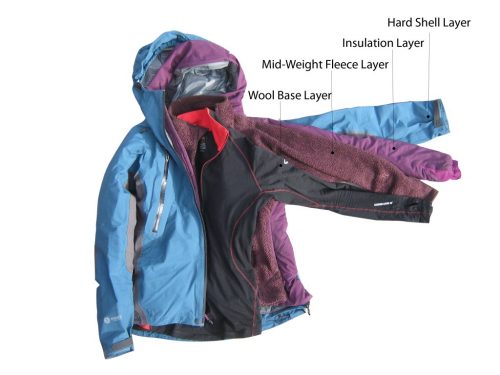Originally published on September 20, 2016 and updated on November 3, 2021.
Whether you’re cross-country skiing, dog sledding, snowshoeing, hiking or snowboarding, getting outside during winter is a special experience.
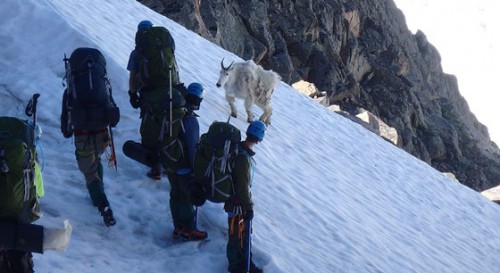
Students experience a unique encounter with a mountain goat while mountaineering with Outward Bound
Winter camping trips mean lots of hot drinks, the crunch of fresh snow underfoot, snuggling into a warm sleeping bag at night, catching snowflakes on your tongue, the warmth of new friendships and the hush of a quiet forest after a snowfall. You might find yourself building shelters out of snow, or digging through snow to find water—experiences most people never get the opportunity to have. There is a magic to being outside in winter, becoming at home in the elements. Even if you’ve never camped before, you’ll soon master the basic skills to stay warm and comfortable, with a little help from your Outward Bound Instructors.
Whether you embark on a winter expedition with Outward Bound, or are planning your own trek into the outdoors, here are a few tips to ensure a successful trip.
Eating and Drinking
The body burns a lot of calories when you’re outside in winter. That’s good news if you like to eat! Skiing and other winter sports require plenty of fuel. And when you’re not moving, you burn calories just keeping warm. When preparing for a winter expedition, make sure your food includes plenty of high calorie snacks and meals. Plus you have cold weather for refrigeration, meaning you can carry foods that would go bad in the heat of summer. So eat up! Winter expeditions are no time to go on a diet. You’ll need those calories. Snack throughout the day, and eat healthy portions at meal time. Need some warm winter recipes? Check out this blog.
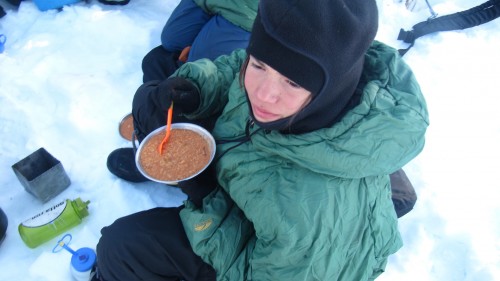
A student enjoys some campfire chili on course in the Boundary Waters
It’s also important to drink plenty of fluids, including water, when active in the winter. The body needs water for efficient processing of fuel, as well as other body processes. It is harder to drink cold water if we’re cold, but it’s important to stay hydrated, even if you have to force yourself to sip and drink all day. Enjoy plenty of hot drinks, too. Hot cocoa can add a boost of warmth at the end of the day with much needed calories. Looking for tips on water sourcing and purification? Check out this article.
On the Move: Clothing
During the day when you’re active, try your best to avoid sweating. This can be done by wearing layers, so that you can remove clothing in steps, wearing just enough to be warm but not sweat. Sweat naturally conducts heat away from your body, lowering your body temperature and making you feel cold. Wet clothes do the same.
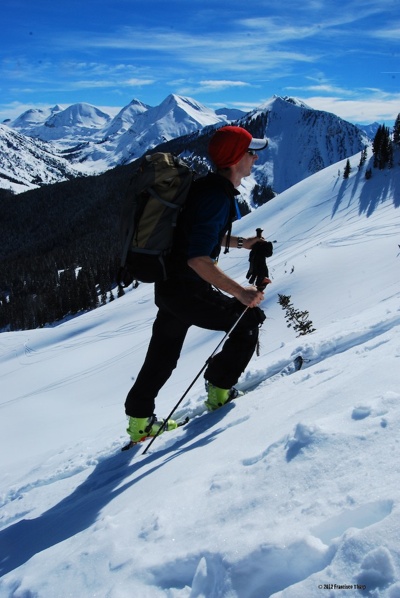
A student skins up a peak while on course with Outward Bound.
Start with a thin base layer next to your skin, usually a synthetic material or soft wool. Outfitter stores sell long underwear and other base layers. It is critical to avoid cotton in cold, wet environments. Cotton is great in summer or very dry environments where evaporation easily carries moisture away from the skin. But it holds moisture next to the skin, which creates a set up for being cold.
Build on your base layer(s), with something heavier and more insulating, like a warm wool sweater or pile jacket. A vest or jacket that cuts the wind is helpful, too. Also be sure to keep a warm hat handy. It’s a quick way to hold in heat, without putting on and taking off layers.
When you’re out for the day, keep layers where you can grab them quickly, so that when you stop for a while you can add a down vest or wind jacket, something to help keep you warm until you’re moving again. If it’s sunny, it can be surprisingly hot, with snow reflecting the heat. You’ll want to remove most of your layers. Later, as the sun goes down and your pace slows, you’ll need to add some insulation to keep warm. At the end of your active day, if any clothing is damp, take a moment to change into something completely dry. It will be much easier to stay warm into the night.
Looking to save money on your layering system? Check out the gear pieces we suggest buying new and the ones you can find used!
Packing
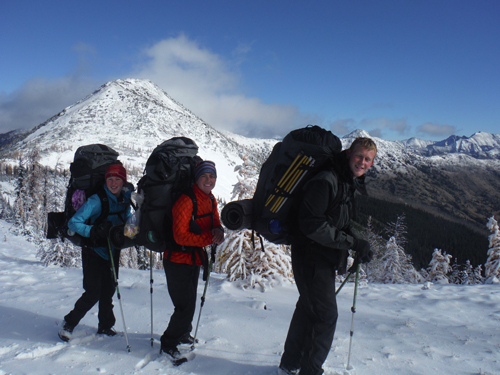
Full packs strategically packed for a long day of backpacking on course with Outward Bound.
As you prepare for the day, think about the things you’ll want to have easy access to and pack accordingly. You might need sunglasses and sunscreen if the sun comes out. Windproof layers will be useful if the wind picks up. You might wear warm layers right up until the time that you put on your pack, then put them where you can easily slip into them when needed. Water and snacks should be accessible. A little planning ahead will make your day flow more easily, and help you to stay comfortable as conditions change.
Learn how to pack a backpack here.
Sleeping
Once all the camp chores are done, the campfire is out and it’s time for some rest, take a minute to move around before you get into your sleeping bag. By doing jumping jacks or anything that gets your blood moving, you can go to bed warm, and make it easier to warm up your sleeping bag. It’s great insulation will keep you warm, but you’ll first have to warm it up! If you have a down bag, fluff it up well for maximum warmth. Create a comfy pillow from some of your extra layers, and consider putting a warm clothing item in your bag. It can add to the insulation factor.
Experiment! There’s no one right combination of techniques for every camper. Some like to wear a warm hat, and others like to tighten the drawstring of their sleeping bag around their head to keep their head warm. Some people love to sleep in long john tops and bottoms. Others prefer less clothing, or more. See what works best for you.
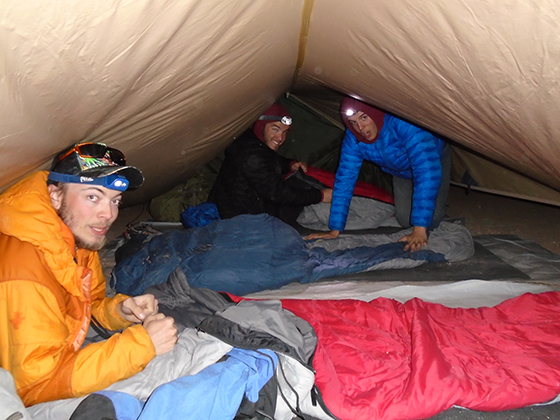
Winter camping with the Outward Bound crew.
A slick trick for helping to warm your sleeping bags is to pour hot water into a nalgene water bottle (be sure it is closed up very well!). Put the bottle into your bag for a few minutes to take off the chill, or to heat the foot area. This will also keep your water bottle from freezing.
One Last Tip…
If you feel cold in the middle of the night, make a quick trip out of your sleeping bag to pee. It may sound crazy, but when you get rid of all that water, your body will have less volume to keep warm, and you’ll notice the difference.
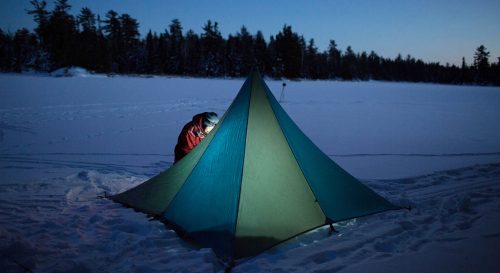
Winter camping with Outward Bound in the Boundary Waters of Minnesota. Photo by Larry Mishkar.
On a crisp clear night when stars are shining brightly, you’ll be glad you made the effort to get out
—out of the sleeping bag, out onto an Outward Bound course and out into the wonder of winter.
To learn more about winter camping trips with Outward Bound, visit www.outwardbound.org or call 866.467.7651 to speak to an admissions advisor today. With a rich selection of expeditions, a wide variety of age groups, stunning locations across the country, and courses that run throughout the year, there’s an Outward Bound expedition for everyone.
Sign-up for our newsletter to keep up on course options, resources, and special offers.
About the Author
CJ Wilson has used her winter camping skills mountaineering and backpacking from the Wind River Range in Wyoming to Patagonia. Her favorite winter sounds are the swish of cross-country skis and the words “Hot drinks are ready!” She writes from her base camp in Asheville NC.
OTHER POSTS YOU MAY LIKE
Read More
Read More
Read More



